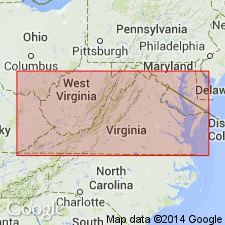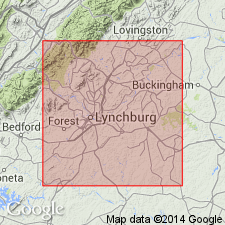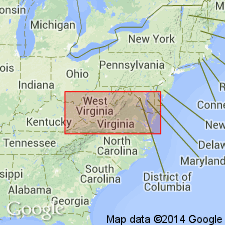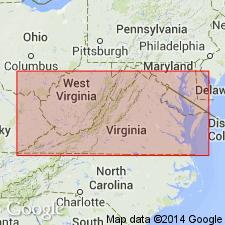
- Usage in publication:
-
- Evington group
- Modifications:
-
- Named
- Dominant lithology:
-
- Schist
- Marble
- Greenstone
- AAPG geologic province:
-
- Piedmont-Blue Ridge province
Summary:
Evington group named in Campbell Co., south-central VA. Includes (ascending) Candler formation (new), Joshua schist (new), Arch marble (new), Pelier schist (new), Mount Athos formation, and Slippery Creek greenstone (new). Overlies Precambrian rocks. Age given as Paleozoic(?).
Source: GNU records (USGS DDS-6; Reston GNULEX).

- Usage in publication:
-
- Evington group*
- Modifications:
-
- Revised
- AAPG geologic province:
-
- Piedmont-Blue Ridge province
Summary:
Evington group in this report includes Candler formation, Archer Creek formation (which replaces Joshua schist and Arch marble), Mount Athos formation (which includes Mount Athos and Pelier schist of Brown, 1953), and unnamed greenstone (Slippery Creek of Brown, 1953).
Source: GNU records (USGS DDS-6; Reston GNULEX).

- Usage in publication:
-
- Evington group
- Modifications:
-
- Overview
- AAPG geologic province:
-
- Piedmont-Blue Ridge province
Summary:
Nomenclature on State map follows Brown (1953; 1958). Age listed as Precambrian-Paleozoic.
Source: GNU records (USGS DDS-6; Reston GNULEX).

- Usage in publication:
-
- Evington Group
- Modifications:
-
- Age modified
- Revised
- AAPG geologic province:
-
- Piedmont-Blue Ridge province
Summary:
Described as youngest Laurentian sequence found in VA Piedmont. Stratigraphic ordering revised by Patterson (1987) to include (ascending) Candler Formation, Moon Mountain greenstone (informal), Mount Athos Quartzite, Slippery Creek Greenstone, Joshua Schist, Arch Marble, and Everona Limestone. Based on correlations, Group should be entirely Early Cambrian according to author.
Source: GNU records (USGS DDS-6; Reston GNULEX).

- Usage in publication:
-
- Evington Group
- Modifications:
-
- Not used
- AAPG geologic province:
-
- Piedmont-Blue Ridge province
Summary:
Evington Group not used on State map. All units other than Candler Formation originally assigned to Evington now mapped as part of Alligator Back Formation, which is considered part of Lynchburg Group.
Source: GNU records (USGS DDS-6; Reston GNULEX).
For more information, please contact Nancy Stamm, Geologic Names Committee Secretary.
Asterisk (*) indicates published by U.S. Geological Survey authors.
"No current usage" (†) implies that a name has been abandoned or has fallen into disuse. Former usage and, if known, replacement name given in parentheses ( ).
Slash (/) indicates name conflicts with nomenclatural guidelines (CSN, 1933; ACSN, 1961, 1970; NACSN, 1983, 2005, 2021). May be explained within brackets ([ ]).

